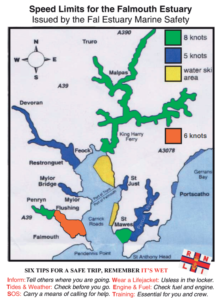THE PORT OF TRURO
Truro Harbour Office, Town Quay, Truro, Cornwall, TR1 2HJ
HARBOUR MASTER
Mark Killingback
CALL:
01872 272130
Recreational
Heading north up the Carrick Road is a voyage to discovering the hidden delights of the Fal and Truro rivers. Unlike many rivers the passage to the head of navigation at Truro is mostly deep apart from the last few miles into the City where you can moor at Town Quay. You could take a leisurely few days exploring this area and still want to come back for more. A variety of mooring locations are available throughout the Estuary provided by Cornwall Council and a number of other operators. The entire Fal estuary holds approximately 4,500 moorings, 1500 of which are located within the Port of Truro.
Mylor creek hides behind the plethora of small craft moorings. Seasonal red/green lateral marks indicate the west going fairway through the moorings leading to Mylor Yacht Harbour, Mylor Yacht Club and Restronguet Sailing Club.
Continuing up North the entrance to Restronguet Creek lies to the west after Weir Point. The approach to Restronguet is relatively shallow and needs sufficient rise of tide to get into the deep water in the entrance of the creek which is marked by a host of small craft moorings. Moorings lead NW and the Pandora Inn sits on the western bank offering a long pontoon which dries at low water.
Continuing up Carrick Road, lateral buoys head NE and lead to Turnaware Bar green mark which keeps you clear of the bar stretching out from Tunaware Point. It also marks the start of the 8 knot speed limit and the start of the River Fal.
The deep water channel heads east for a couple of cables before turning north where you can find a row of large visitor mooring. River patrols are regularly undertaken of the visitor moorings and mooring or anchoring fees are collected. The Patrol boat crew are able to provide information and assistance to customers.
For the next two miles large mooring buoys are dotted along the channel providing sheltered mooring for large commercial vessels who make use of one of Britain’s deepest rivers. Just before the King Harry chain ferry there is a pontoon allowing access for the ferries and dinghies going to the National Trust Tressilick Gardens and House.
Contnuing to follow the main channel you will come to our marina at Malpas. The nearby Heron Inn serves food and drink and is easily accessed by dinghy. During 2021 additional pontoons will be installed and a café opened.
Holiday accommodation is available at Malpas, Waterfront House is situated right on the water’s edge within the Malpas Marina, with a stunning vista across the water to Trelissick and Tregothnan Estates, it sleeps up to 8 people and allows dogs. For more details please contact Cornwall Hideaways on 01872 561642 or view their website.
The river divides at Malpas with the Tresillian River heading off to the north east and the Truro River continuing South West as it rounds Victoria point on the northern bank. The channel winds its way upstream then narrows as it enters the canal like Lighterage Quay and Tidal Barrage with Truro Cathedral in the background.
The Tidal Barrage is usually open, it may be shut on exceptionally high tides to protect the city, in which case a waiting pontoon is located downstream of the barrage.
Once through the barrage, buoys give way to posts marking the channel at close intervals but be sure identify the next mark before heading to it. The channel hugs the starboard then port banks before being punctuated by a Supermarket on the port side. The river divides and the visitor moorings alongside the quay wall and harbour masters office can be seen ahead. Boats staying here for any length of time should be capable of taking the ground.
There are a number of passenger craft that operate within the Harbour, with a seasonal (April – October) service linking Falmouth to Truro. In addition, a number of ‘tripping’ and ferry boats use the area.

Water Ski and Jet Skis
Any personal Water Craft or Jet Skis require a permit to navigate in the port of Truro; Maritime bylaws for the protection & regulation of navigation within Truro Harbour and Penryn Harbour. Made under Section 83 of The Harbour Docks and Piers Clauses Act 1847 and The Truro & Penryn Harbour Orders.
Mariners are advised that byelaw 70 states :JET SKIS, JET BIKES ETC No person shall engage or take part in jet skiing etc. except with the written permission of the Harbour Master given either specifically or generally, and only in such areas as may be designated and in accordance with such reasonable conditions as may be imposed by the Harbour Master.
With reference to reasonable conditions, jet skis, jet bikes and Personal Water Craft may only launch from Mylor Yacht Harbour slipway and may only proceed to the water ski and jet ski area in Carrick Roads returning in a reciprocal manner. A permit is compulsory and available by contacting Truro Harbour office or the patrol vessel call sign ‘Carrick 2’ on Ch 12 VHF or mobile number 07483 332964. The license application form can be found on our Document Centre under Maritime Forms.
Wild Swimming
This is becoming very popular but before undertaking a personal risk assessment should be undertaken. Particular attention should be made of personal fitness for the swim and swim clothing appropriate for the time of year and water temperature.
Swimmers must consult tide tables and weather forecast before undertaking a swim to understand tidal flow or current that may be encountered and the size of any waves in open water.
Swimmers should NOT swim near navigational channels or fairways where they may encounter powered craft and not be seen.
Swimmers should use all possible methods to be seen by other water users. Wearing a bright swimming hat and towing a light weight hi-visibility float will help.
Kayaks and stand up paddle boards
These craft must comply with the ‘Collision Regulations’ as do other craft used or capable for transport on water. Paddle powered craft should exercise caution near navigational channels or fairways where they may encounter large powered craft and not be seen.
Paddle powered craft must not impede powered craft which cannot safely leave navigational channels or fairways.
When paddling at night these craft must exhibit a light.
